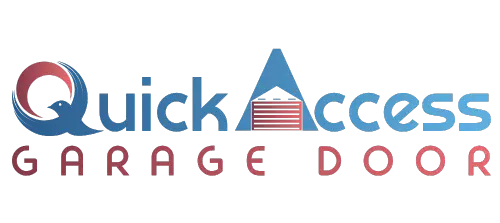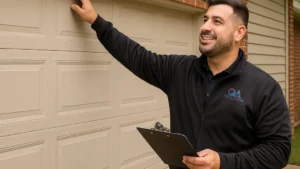Choosing the Right Garage Door for Your Home
Making the decision when choosing the right garage door for your Dallas home is more significant than many realize. It’s a critical choice impacting not just how you access your garage, but your home’s overall curb appeal, security posture, energy efficiency, and even its market value. A garage door can dominate up to 40% of your home’s facade, making the process of choosing the right garage door a vital home improvement project. This comprehensive guide aims to simplify the process, walking you through the essential factors to consider, ensuring your final decision results in a door you love and that serves you well for years. When you invest time in choosing the right garage door, you’re making a smart investment in your property’s future and daily convenience.
The journey of choosing the right garage door involves navigating several key considerations. It starts with understanding the different garage door materials and their unique properties. Then, you’ll explore various garage door styles to find one that complements your home’s architecture. Insulation properties (R-value) play a crucial role in comfort and energy savings, while safety features are non-negotiable. We, at Quick Access Garage Door Repair in Dallas, TX, have guided countless homeowners through the process of choosing the right garage door, and we understand the weight of this decision. Remember, the ultimate goal in choosing the right garage door is finding the perfect blend of aesthetics, functionality, durability, and security.
“Home is where one starts from.” – T.S. Eliot
Understanding Garage Door Materials: The Core Decision in Choosing the Right Garage Door

The material you select is arguably the foundational step in choosing the right garage door. This choice dictates the door’s longevity, required maintenance, visual appeal, insulation potential, and overall resilience. Let’s delve into the most common garage door materials available to Dallas homeowners, helping you make an informed choice in choosing the right garage door for your specific needs:
Steel: The Popular All-Rounder
Steel garage doors dominate the market, offering an excellent combination of strength, affordability, and design flexibility. They come in various thicknesses (gauges), with lower gauges indicating thicker, more robust steel (e.g., 24-gauge is stronger than 27-gauge). Modern steel doors can feature realistic wood-grain embossing and be painted in virtually any color, allowing them to fit diverse architectural styles. When choosing the right garage door made of steel, strongly consider multi-layer construction (steel + insulation + steel). This enhances thermal performance (R-value), increases dent resistance, and ensures quieter operation. While generally low-maintenance, steel can dent upon impact, and scratches compromising the finish can lead to rust, particularly in humid conditions. Proper finishing is key when choosing the right garage door in steel.
Aluminum: Lightweight and Modern
Aluminum doors are prized for being lightweight and highly resistant to rust and corrosion, making them an excellent choice for areas with high humidity. They often form the framework for contemporary doors featuring large panels of frosted or clear glass, offering a sleek, modern aesthetic. While rust isn’t an issue, aluminum is softer than steel and thus more susceptible to denting. The process of choosing the right garage door using aluminum involves weighing its modern appeal and corrosion resistance against its lower dent resistance compared to steel. Their lighter weight makes them suitable for very wide doors and can put less strain on the opener mechanism.
Wood: Unmatched Natural Beauty
For timeless elegance and authentic charm, solid wood garage doors are unparalleled. Available in various species like cedar, redwood, hemlock, and fir, they can be custom-designed to create stunning focal points. Wood is a natural insulator and provides a warm, rich aesthetic. However, this beauty comes at a cost – both in initial price and ongoing maintenance. Wood doors require regular painting or staining (every few years) to protect against moisture, preventing warping, cracking, and rot. They are also significantly heavier than steel or aluminum doors. If aesthetics are paramount in choosing the right garage door, and you are committed to the necessary upkeep, wood offers a truly premium look.
Wood Composite: The Look of Wood, Less Work
Wood composite doors provide a practical alternative for those who love the wood aesthetic but desire less maintenance. Constructed from recycled wood fibers and resins, often applied over a frame, they effectively mimic wood grain textures. They are more stable than solid wood, resisting warping and cracking better. While they still require some maintenance (periodic painting), it’s generally less intensive than solid wood. This makes them a smart consideration when choosing the right garage door for a balance of appearance and practicality.
Fiberglass: Wood Look, Dent Resistant
Fiberglass garage doors offer another route to achieving a wood-like appearance, often molded with realistic grain patterns. Their key advantage is resistance to denting, cracking, and rust, making them suitable for busy households or coastal areas. They are also relatively lightweight. Downsides include potential brittleness in extreme cold (less of a concern in Dallas) and the possibility of the color finish fading over time due to UV exposure. Insulation quality varies based on construction. Evaluating the local climate is part of choosing the right garage door, and fiberglass presents a unique set of pros and cons.
Vinyl: The Durability Champion
Often called “the carefree option,” vinyl garage doors are exceptionally durable and require minimal maintenance. They are highly resistant to dents, scratches, rust, cracking, and fading. If you have active kids or live in a harsh climate, vinyl is hard to beat for longevity. The main trade-off is typically a more limited range of style and color options compared to steel or wood. If maximum durability and near-zero maintenance are your top priorities when choosing the right garage door, vinyl deserves serious consideration.
Carefully weighing the pros and cons of these materials is a critical first phase in choosing the right garage door that aligns with your home’s needs, your budget, and your tolerance for maintenance in the Dallas environment.
Style Synergy: Matching Your Door to Your Dallas Home
Once you have a handle on materials, the next exciting step in choosing the right garage door is selecting a style that harmonizes with your home’s architectural character. A well-chosen style elevates curb appeal, while a mismatch can look jarring. Explore these popular garage door styles to guide your process of choosing the right garage door:
Traditional Raised Panel: Classic and Versatile
This is arguably the most ubiquitous style, featuring symmetrical raised rectangular panels, available in long (fewer, wider panels) or short (more, narrower panels) configurations. Its timeless design makes it suitable for a vast range of home styles found in Dallas, from Colonial and Cape Cod to Ranch and many transitional designs. It’s often considered a safe but effective choice when choosing the right garage door for broad appeal.
Carriage House Style: Charm and Character
Designed to replicate the look of historic swing-out carriage house doors, these operate conveniently as modern overhead doors. They often boast distinctive features like decorative hardware (large hinges, handles), crossbuck overlays (X-patterns), or arched window designs. This style adds significant charm and character, making it an ideal choice when choosing the right garage door for homes with Craftsman, Farmhouse, Victorian, Tudor, or Country aesthetics.
Contemporary/Modern: Sleek and Minimalist
Contemporary garage doors emphasize clean lines, simple forms, and often utilize materials like aluminum and glass. Features might include flush (flat) panels, minimalist horizontal grooves, or asymmetric layouts of windows (often frosted or opaque for privacy). This style is the perfect complement when choosing the right garage door for Modern, Mid-Century Modern, Minimalist, or International style homes. They create a sophisticated, uncluttered look.
Visualizing these styles on your own home is incredibly helpful during the process of choosing the right garage door. Many manufacturers and dealers, including Quick Access Garage Door Repair, can offer visualization tools or consultations to help you see how different styles will look on your specific property. Don’t underestimate the impact of style when choosing the right garage door – it’s a major aesthetic decision.
Quick Guide: Garage Door Material Comparison
Insulation Insights (R-Value): Comfort and Efficiency
A critical, yet often underestimated, factor in choosing the right garage door is its insulation value, measured as R-value. Simply put, a higher R-value signifies greater resistance to heat flow – meaning the door is better at keeping heat out during Dallas summers and keeping heat in during colder periods. This is not just a minor detail; it’s essential when choosing the right garage door for comfort and potential energy savings.
Why prioritize insulation (R-value) when choosing the right garage door?
- Enhanced Energy Efficiency: An insulated garage door helps stabilize the temperature within your garage. If the garage is attached to your home, this buffer zone significantly reduces heat transfer into your living areas, potentially lowering your heating and cooling costs. Effective sealing around the door, akin to principles for home air sealing discussed by resources like ENERGY STAR Duct Sealing guides, complements the insulation.
- Increased Comfort: It transforms your garage from an area of extreme temperatures into a more usable space year-round, whether for parking, storage, a workshop, home gym, or even a home office space (which might have implications noted in IRS Publication 587 on Business Use of Your Home).
- Improved Durability: Insulated doors typically utilize a sandwich construction (e.g., steel layers enclosing an insulation core). This multi-layer design inherently makes the door stronger, more rigid, and more resistant to dents and impacts compared to non-insulated, single-layer doors.
- Quieter Operation: The insulation core effectively dampens vibrations and noise, leading to significantly quieter opening and closing cycles – a welcome benefit, especially if bedrooms are located near or above the garage.
Common insulation materials used in garage doors are polystyrene (EPS) and polyurethane foam. Polyurethane generally provides a higher R-value per inch of thickness and often fills the door cavity more completely. When choosing the right garage door, look for stated R-values, typically ranging from R-6 (basic insulation) up to R-18 or higher for premium doors. For Dallas homeowners with attached garages or those who use their garage frequently, aiming for an R-value of R-10 or higher is generally recommended during the process of choosing the right garage door. While specific tax benefits like the Insulation Tax Credit might have broader requirements, selecting an energy-efficient door is always a wise investment.
“An investment in knowledge pays the best interest.” – Benjamin Franklin
Considering your garage’s use case and its connection to your home is vital when choosing the right garage door with the appropriate insulation level. It’s a decision that pays dividends in comfort and efficiency.
Powering Your Door: Understanding Garage Door Openers
While the door itself is the main event, the garage door opener is the engine that drives it. Selecting the right opener is a crucial part of choosing the right garage door system for seamless, reliable operation. Modern openers offer various drive types, power levels, and features impacting noise, speed, and longevity.
Opener Drive Types:
- Chain Drive: These are often the most affordable option. They use a metal chain to pull the trolley that moves the door. While reliable and strong, they tend to be the noisiest type, which can be a consideration if living spaces are adjacent to the garage.
- Belt Drive: Similar to chain drives but using a reinforced rubber belt instead of a chain. This results in significantly quieter and smoother operation, making them ideal for homes with attached garages or nearby bedrooms. They are typically priced higher than chain drives but offer enhanced comfort. When prioritizing quietness in choosing the right garage door system, a belt drive is often preferred.
- Screw Drive: These openers use a threaded steel rod to move the lifting mechanism. They have fewer moving parts, potentially requiring less maintenance. They offer moderate noise levels, generally quieter than chain drives but potentially louder than belt drives, and perform well in consistent temperatures.
- Direct Drive (Wall Mount/Jackshaft): These innovative openers mount directly on the wall beside the garage door, connecting to the torsion bar. They free up ceiling space, making them perfect for garages with high or obstructed ceilings. They are exceptionally quiet and offer a clean look. While often the most expensive option, their space-saving and quiet operation make them a compelling choice when choosing the right garage door opener for specific garage layouts.
Opener Power (HP):
Garage door openers come in different horsepower (HP) ratings, typically 1/2 HP, 3/4 HP, or higher. For most standard residential doors (steel, aluminum, single wood), a 1/2 HP opener is sufficient. However, for heavier doors (solid wood, oversized doors, carriage house styles) or for faster opening speeds, a 3/4 HP or even a 1+ HP motor is recommended. Choosing adequate power ensures longevity and prevents strain on the motor, an important factor in choosing the right garage door opener.
Modern Opener Features:
Today’s openers offer more than just basic up-and-down functionality. Consider these features when making your selection:
- Wi-Fi Connectivity / Smart Home Integration: Allows you to monitor and control your garage door from a smartphone app anywhere, receive alerts, grant temporary access, and potentially integrate with systems like Alexa or Google Home.
- Battery Backup: Provides power to operate the door during electricity outages, ensuring you’re never locked in or out. This is a highly recommended feature for convenience and safety.
- Rolling Code Technology: Enhances security by changing the access code each time the remote is used, preventing code grabbing by potential intruders.
- Soft Start/Stop: Reduces wear and tear on the door and opener by gradually accelerating and decelerating the door’s movement.
- LED Lighting: Integrated, energy-efficient lighting provides bright illumination for your garage.
Selecting the appropriate opener and features is integral to the overall success of choosing the right garage door system. Discussing your door’s weight and your desired features with a professional from Quick Access Garage Door Repair ensures compatibility and optimal performance.
Safety First: Essential Garage Door Safety Features
Safety should be a non-negotiable priority when choosing the right garage door and opener system. Garage doors are heavy and operate under significant tension, making safety features absolutely critical to prevent accidents and injuries. Modern garage doors and openers are equipped with several mandated and recommended safety mechanisms:
- Photo Eye Sensors (Safety Reversal System): These are small sensors mounted near the bottom of the door tracks. They project an invisible beam across the opening. If anything breaks this beam while the door is closing (a person, pet, or object), the door automatically reverses direction. Federal law mandates these sensors on all garage door openers manufactured since 1993. Regularly testing these sensors is crucial for safety.
- Mechanical Auto-Reverse: If the closing door physically encounters an obstruction, a mechanism within the opener senses the resistance and automatically reverses the door. This provides a secondary layer of protection if the photo eyes fail or are misaligned.
- Manual Emergency Release: Usually a red cord hanging from the opener trolley. Pulling this cord disengages the opener, allowing the door to be operated manually in case of a power outage or opener malfunction. Knowing how to use this is essential.
- Tension Springs (Torsion or Extension): While not safety features in the same way, properly functioning and balanced springs are vital for safe operation. They counterbalance the door’s weight, allowing the opener (or a person) to lift it easily. Broken springs can cause the door to slam shut or become extremely heavy and dangerous. Spring replacement requires specialized tools and knowledge and should always be handled by professionals like those at Quick Access Garage Door Repair.
- Pinch-Resistant Panel Design: Many modern doors feature panel designs where the sections meet in a way that pushes fingers out of the joints as the door closes, reducing the risk of pinching injuries. This is an important design consideration when choosing the right garage door, especially for families with children.
Ensuring these safety features are present and functioning correctly is paramount after installation and through regular maintenance checks. Never compromise on safety when choosing the right garage door system. If your garage is used for business purposes, maintaining safety standards is crucial, and keeping records of maintenance could be relevant for tracking business expenses as detailed in IRS Publication 535.
Windows and Hardware: The Finishing Touches
Beyond the core material and style, windows and decorative hardware offer opportunities to personalize your door and further enhance curb appeal. These elements are key considerations in the final stages of choosing the right garage door.
Windows: Light and Style
Adding windows (also called “lites”) to your garage door can dramatically alter its appearance and functionality. Benefits include:
- Natural Light: Windows allow daylight into the garage, making it a brighter, more pleasant space without needing to turn on lights during the day.
- Aesthetic Enhancement: Windows break up the large surface area of the door, adding visual interest and character. They come in various shapes (rectangular, square, arched), sizes, and arrangements (e.g., a row across the top panel, vertical placement).
- Style Reinforcement: Specific window designs, like arched windows with grilles (divided lites), reinforce styles like Carriage House, while long, narrow windows complement contemporary designs.
Considerations when adding windows include privacy (frosted, obscure, or tinted glass options are available) and insulation (windows typically lower the overall R-value of the door, though insulated glass options exist). Deciding on windows is an important step in choosing the right garage door design.
Decorative Hardware: Adding Authenticity
Decorative hardware is particularly popular for Carriage House style doors but can add flair to other styles too. These pieces mimic the functional hardware of old-fashioned swing-out doors:
- Handles: Various styles, from simple pull handles to ornate ring pulls.
- Hinges (Strap Hinges): Decorative straps that give the appearance of functional hinges.
- Clavos/Studs: Decorative nail heads that add rustic detail.
This hardware is purely cosmetic for modern overhead doors but adds a layer of authenticity and visual appeal. It’s typically made from stamped steel or cast aluminum with durable finishes. Selecting the right hardware complements the overall design and is a final touchpoint in choosing the right garage door.
“The details are not the details. They make the design.” – Charles Eames
Paying attention to openers, safety, windows, and hardware ensures that the process of choosing the right garage door results in a system that is not only beautiful but also safe, convenient, and perfectly suited to your needs.
Further Resources
While this guide focuses on choosing your garage door, related home improvement and energy efficiency topics may be of interest. Please note these resources cover broader topics and may only be tangentially related:
- ENERGY STAR – Duct Sealing (General home air sealing concepts)
- IRS – Energy Efficient Home Improvement Credit (General info on potential home improvement credits)
- IRS – Publication 587: Business Use of Your Home (Relevant if garage space is used for business)
- IRS – Publication 535: Business Expenses (General business expense information)
- ENERGY STAR – Insulation Tax Credit (Broader insulation credit info)
Disclaimer: The information provided in this article is intended for general guidance and informational purposes only. While we strive to provide accurate and up-to-date content, garage door specifications, building codes, and regulations can change.
This article does not constitute professional advice. Homeowners should consult with qualified professionals, such as the experts at Quick Access Garage Door Repair (Phone: 972-972-9302), for specific recommendations tailored to their individual needs, home structure, and local requirements before making any decisions regarding garage door selection, installation, or repair.
Reliance on any information provided in this article is solely at your own risk. Quick Access Garage Door Repair is not liable for any errors or omissions, or for any actions taken based on the information presented here.





